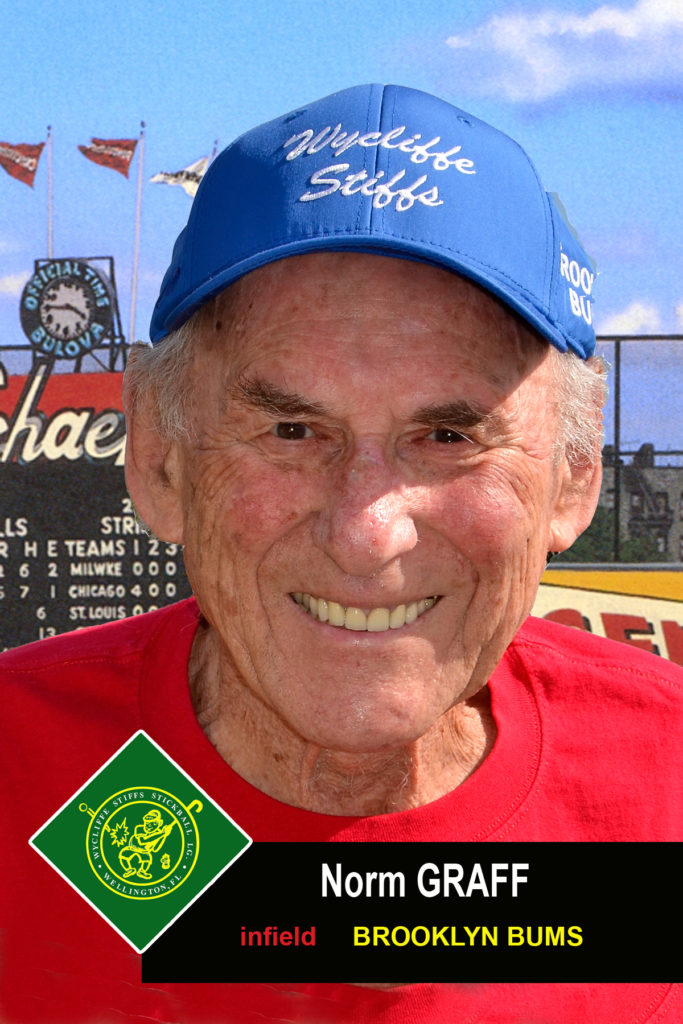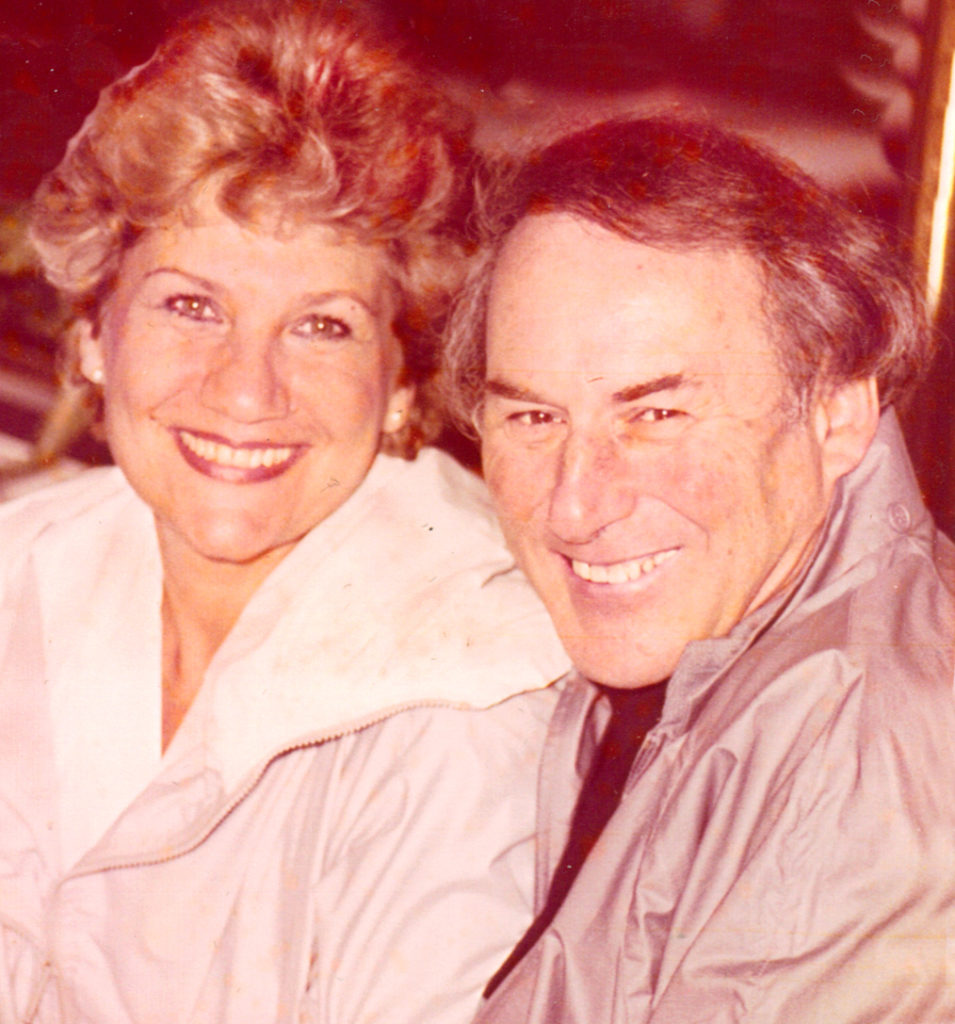Posted on Posted onBy Palmer Hasty

Brooklyn Native Norm Graff Played in the Wycliffe Stiffs
Stickball League Until he was 89 Years Young
By Palmer Hasty
When I asked the oldest Brooklyn native in the Wycliffe Stiffs stickball league when he was born, Norm Graff said: “I was born in 1926 and there were no hospitals in those days so my mother had me in the house, well, to be exact, it was in the basement.” Graff grew up at 334 Vermont Street in East New York. He said it was “sort of like a ghetto back then.” He swears he had a great childhood.
We continue our series of interviews with retired Brooklyn natives who are also stickball players in the Wycliffe Stiffs stickball league in Wellington, Florida.
Norm Graff was born on December 16, 1926, at 34 Vermont Street in East New York. That was of course, three years before the Great Depression of 1929. As Graff remembered it: “There were no hospitals in those days, my mother had me in the house. Well, to be exact, I was born in the basement.”
After the great Depression, economic conditions were so bad the Graff family lost their house in the early 1930s, and had to move into an apartment building on New Jersey Avenue in East New York between Atlantic and Liberty avenues. Graff said it was “sort of like a ghetto back then.”
Graff eventually became a successful air conditioner equipment salesman and raised two children. His daughter became a well known stage actress who played the character Fontaine in the original Broadway production of Victor Hugo’s masterpiece Les Miserables. Graff retired in 1993 and moved to home he already owned in Wellington , Florida. He currently splits his time between Wellington and Monticello, New York.
Graff is by far was the oldest player in the league for many years until he had to stop playing stickball last year.
BE: When were you born?
NG: “I was born in 1926 and there were no hospitals in those days so my mother had me in the house, well, to be exact, it was in the basement.” I grew up at 334 Vermont Street in East New York. He said it was sort of like a ghetto back then. I swear that I had a great childhood.
BE: What was it like living in a poor section of Brooklyn as a kid during the Great Depression? It must have been tough.
NG: “Yes it was. Especially for my father. It was so difficult for people to find work. My poor father lost the house. A lot of people lost everything because they had money in the stock market. My father didn’t do the stock market, the economy was so bad my father just couldn’t find enough work to make the payments. And he had to feed four kids. In the early 1930s we had to move into an apartment building on New Jersey Avenue between Atlantic Avenue and Liberty. I remember the Long Island Railroad made noise all through the night and we complained about it…but we got used to it.
And here’s something weird for you. When we finally moved away to another place, I remember nobody could sleep because we had become so used to falling asleep to the sounds of the railroad.”
BE: Did you also play Stickball as a kid?
NG: “Of course we played stickball. But our primary game was punch ball. By the way, some of baseball’s greats, Jackie Robinson, Yogi Berra, and Rocky Calovito, they all played punchball. We played with the “spaldeen” ball and it went into the gutter along the curb all the time. You had to be creative to figure out ways to get it out. I remember once when I was 7, I went to a grocery store nearby and borrowed one of those things that have claws on the end of a pole, you know, one of those things you use to grab something way up on a shelf.
The only time we stopped playing ball was when a car came down the street and since there weren’t many cars in those days, we played all the time, we had great childhoods.”
BE: Where did you go to school?
NG: I went to Jefferson High. I know you did an interview with Alan Miller, that successful health care guy who went to Jefferson. He played on the best basketball team Jefferson ever had, the 1954 undefeated city champions. Shelly Winters also went to Jefferson High.
BE: So you joined the Navy right out of high school?
NG: “Yes. I joined the Navy in 1944, six months after I got out of high school, two weeks before my 18th birthday. I’ll tell you a story. I had to go to 42nd Street for my physical and mental aptitude test. I go in to see the Navy psychiatrist and he’s asking me all these questions and suddenly out of the blue he asks me: Does anybody in your family suffer from insanity?
So I said to him: “No, they all seem to enjoy it.“
What can I say, I was young. So then he said: “That’s enough, now get out of here.”
I don’t think he had a sense of humor.”
BE: What did you do in the Navy?
NG: “I got lucky. I was stationed in Geneva, New York, at the Samson Naval Training Station. I did what’s called ‘ship’s company’. I put coal in the burners that heated the barracks. I was in charge of three barracks. Included in my duty was the waves’ barracks. In the Navy the women were called ‘waves’. They liked me and sometimes they would sleep near the coal burners. They were all older than me. That was the best duty.”
BE: Is it true that your daughter was a Tony winning actress on Broadway?
NG: “Yes that’s true. Randy Graff. She won a Tony for her supporting actress role in a show called “A Class Act.” She was also nominated for two other Tony awards. She played Fantine in the original Broadway production of Les Miserables in 1987. That production “swept the Tony Awards”, as Johnny Carson said.
I’m proud of her, she’s had a long career acting and singing on Broadway and television.”
For readers who would like to see Norm Graff’s daughter, Randy Graff, performing on the Johnny Carson Show in 1987, please click here.
BE: Tell us about Pine Hill Lodge?
NG: When we were young we used to go to a place called Pine Hill Lodge in Mount Freedom, New Jersey. I have to tell you, those were the best years of my life. Me and my friends, a bunch of guys from Brooklyn would go there during summer, everybody was single, it was great. Today I think it’s a housing project or something. Pine Hill Lodge had everything, you could play any sport you wanted. And a lot of guys, including me, met their eventual wives there.
BE: How did you meet your wife Gladys?
NG: “It was 1951. I was at Pine Hill Lodge on vacation. I was walking down the road, I forgot where I was going but coming the other way towards me was this beautiful girl. Gladys Snyderman was her name. She was 19, and she had on riding pants, boots, a blue gingham blouse I remember distinctly, and scarf around her neck So as I’m approaching she gave me a very big smile. I remember I was saying in my head, keep walking Norm, you can’t afford this girl. And you know what (laughing), I was right. I learned that was her first time up there, she was there with a bunch of her girlfriends. I have to tell you, every guy at Pine Hill Lodge would have killed to be with Gladys.”
BE: Do you remember your first date with your wife?
NG: I have to tell you, every guy at Pine Hill Lodge would have killed to be with Gladys. But she kept coming to me. To this day I don’t know why. It was two years after I met her. We were both going back there and one night we were playing cards at the Lodge. The next day, it was Memorial Day, I called Gladys up for a date and she said sure. I took her to Ebbets field. The Dodgers were playing the Phillies. Robin Roberts the Hall of Famer was pitching against Don Newcomb. Before we went to the game I took her to an Italian restaurant for veal parmesan and spaghetti. We had a great time.”

BE: Do you remember the name of the restaurant?
NG: “Yes. It was called Palermo’s Pizzeria & Restaurant. I was trying to impress her you know…The owner sent us over a bottle of wine on the house…then we went to Ebbets Field and we had great seats…Jackie Robinson was second base, Gil Hodges was First Base and Pee Wee Reese was short stop. Carl Ferillo was right field, duke Synder was center field…I loved the Dodgers.”
BE: So what happened between you and Gladys?
NG: “I take her for an Italian meal…I take her to Ebbets field…we eat a bag of peanuts and at the time, get this, I was thinking I was going all out for this girl. This was the 1950s, right? To make a long story short; That was our first date and three weeks later I gave her a ring, and she took it, then four months later I was married to her. And this coming November is going to be 64 years I’m with my beautiful wife. I’ve never been so lucky in life as when she said yes. And recently she celebrated her 85th birthday, and she’s still a knockout.”
Photos courtesy of Wycliff Stiffs and Norm Graff.